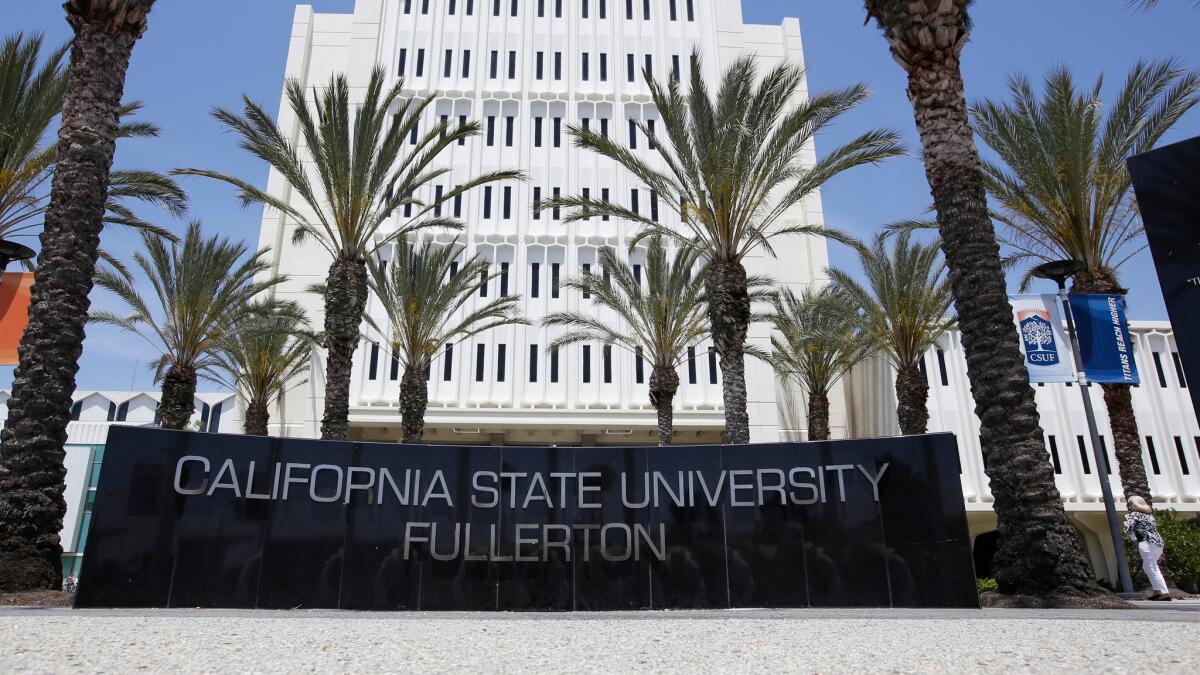Column: Free tuition at California public colleges helped the state prosper. There’s no reason it can’t again

SACRAMENTO — It wouldn’t be “free college” for all — no one anywhere is proposing that — but a state university diploma could become more affordable for many California students.
Under a new law, full-time community college students are already excused from paying course fees of $46 per unit. That’s good for both their freshman and sophomore years. The next logical step is for those students to receive two more years of tuition-free education if they transfer to a California state university.
Bottom line: California residents could obtain a CSU bachelor’s degree after four years without paying a dime in course fees or tuition. Of course, they’d still have to fork out thousands for room, board and books. So there’d be no “free college.”
The state currently is paying $85 million for the community college fee waivers. Exempting community college transfers from two years of CSU tuition would cost an additional $300 million-plus.
The state can’t afford it? Rubbish. Generations of California students — mine included — attended the University of California, state universities and community colleges tuition-free. It wasn’t until the 1970s and 1980s that tuition and course fees began creeping on campuses.
Why’d that happen? The state switched priorities and began spending its money or other stuff: enhanced welfare and healthcare for the poor, prisons and — especially — K-12 schools to compensate for property tax losses after Proposition 13 was passed in 1978.
Assemblyman Miguel Santiago (D-Los Angeles), who spearheaded the legislation to provide community college fee waivers, has just introduced a bill, AB 1862, to offer two tuition-free years at CSU for community college transfers.
To be eligible for free tuition, a transfer would need to have obtained a community college degree and taken 18 units toward a major.
“These students are absolutely prepared to be successful,” Santiago told me. “They should be able to get a [CSU] degree in two years. ... They have to make a commitment. They can’t be goofing around.”
A bill blurb reads that the measure “will encourage and incentivize more students to enroll in four-year institutions following community college, help more students graduate with less debt and will grow the number of workers with undergraduate degrees needed to compete in the global economy.”
Why didn’t he include UC in his bill? Because most community college graduates transfer to CSU, Santiago said. “This is a starting point.”
Santiago, 46, attended Moorpark College, then transferred to UCLA for his bachelor’s degree. He served on the L.A. Community College District board before being elected to the Assembly in 2014.
Current annual tuition at a Cal State school is roughly $7,300, including campus fees. That’s a relative bargain. UC tuition, with fees, is around $14,000. Private university tuition can be triple or quadruple that of UC’s.
For poor and lower middle-income students, there’s lots of financial help: state Cal Grants, federal Pell Grants and campus “institutional aid.”
Many financially pressed students get their tuitions waived. That’s good. What isn’t good is that the other students make up for it by paying higher tuition. One-third of the paying students’ tuition goes to replace the poorer kids’ tab.
It’s good public policy to exempt poor kids from tuition. But the entire public should pay for it through the state general fund.
Critics of free tuition for all — including some presidential candidates — object to students getting a “free ride.” But nobody is advocating for a complete freebie. Tuition represents only 25% to 30% of the cost of attending a CSU school. Housing expenses range from $10,600 annually at Cal State Fresno to about $18,000 at San Diego State,.
Total costs — tuition, housing, meals, books, parking — vary from roughly $25,000 at Cal State Stanislaus to nearly $30,000 at Cal Poly San Luis Obispo.
Free tuition has become a major issue in the presidential campaign. Democrats are divided.
Vermont Sen. Bernie Sanders kicked it off by advocating free tuition for every public university student when he ran for president in 2016. Massachusetts Sen. Elizabeth Warren agrees, saying she’d pay for it by imposing a “wealth tax” on people worth more than $50 million.
In last week’s Democratic debate, Minnesota Sen. Amy Klobuchar mischaracterized their positions as advocating “free college for all.”
Pete Buttigieg, the moderate former mayor of South Bend, Ind., put it this way:
“We’ve got to be making sure that we target our tax dollars where they will make the biggest difference. And I don’t think subsidizing the children of millionaires and billionaires to pay absolutely zero tuition at public colleges is the best use of those scarce taxpayer dollars.”
But our public libraries are free to everyone. So are public K-12 schools. At public parks and beaches, rich and poor alike pay the same fees — when there are any.
I asked Santiago why he was OK with providing free tuition for wealthy students.
“No. 1, rich kids aren’t going from high school to community college to Cal State,” he replied. “No. 2, let’s say some are. It’s an anomaly. It would probably cost more to weed them out than we’d save.”
But his bill will be a hard sell to other legislators and Gov. Gavin Newsom. They’ve all got their own pet spending projects.
“I’ve been there before,” Santiago said. “People said that about the community college fees. This will get the conversation going.”
Free tuition at California public colleges once helped the state prosper by making a BA more affordable and supplying a skilled workforce. There’s no reason it couldn’t again.
More to Read
Sign up for Essential California
The most important California stories and recommendations in your inbox every morning.
You may occasionally receive promotional content from the Los Angeles Times.











